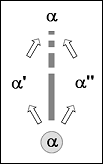Last updated on June 7th, 2020
- adaptation
- Any heritable characteristic of an organism that improves its ability to survive and reproduce in its environment. Also used to describe the process of genetic change within a population, as influenced by natural selection.
- adaptive radiation
- The diversification, over evolutionary time, of a species or group of species into several different species or subspecies that are typically adapted to different ecological niches.
- alien species
- A species that does not normally occur in an area but which has been deliberately or accidentally introduced by human activity.
- allopatric speciation
 Speciation that occurs when two or more populations of a species are geographically isolated from one another sufficiently that they do not interbreed.
Speciation that occurs when two or more populations of a species are geographically isolated from one another sufficiently that they do not interbreed.
In the figure, alpha’ and alpha” are allopatric species isolated by a natural barrier (sea, river, mountain chain, desert, etc.), but derived from a mother-species alpha.
If the barrier disappears, or if the individuals of the two populations meet, the two allopatric populations show the ability to interbreed again.
- allopatry
- Living in separate places.
- biodiversity
- “The variability among living organisms from all sources including terrestrial, marine and other aquatic ecosystems and the ecological complexes of which they are part; this includes diversity within species, between species and of ecosystems.” (United Nations Biodiversity Convention 1992)
- biogeography
- The study of patterns of geographical distribution of plants and animals across Earth, and the changes in those distributions over time.
- biomass
- The total weight of living matter in a population.
- character
- Any recognizable trait, feature, or property of an organism.
- cleptoparasite
- An organism that exists by cleptoparasitism.
- cleptoparasitism
- A form of multiple parasitism in which a parasite preferentially attacks a host that is already parasitized by another species.
- coadaptation
- Beneficial interaction between organisms belonging to different species.
- coevolution
- Evolution in two or more species, such as predator and its prey or a parasite and its host, in which evolutionary changes in one species influence the evolution of the other species.
- colony
- A group of animals or plants living together and dependent on each other to a greater or lesser extent.
- contiguous
- Very near or touching.
- continental drift
- The process by which the continents move as part of large plates floating on Earth’s mantle.
- convergence
- The process by which a similar character evolves independently in two species.
- convergent evolution
- The evolution of species from different taxonomic groups toward a similar form; the development of similar characteristics by taxonomically different organisms.
- de facto
- In fact; in reality. Something which exists or occurs de facto is not the result of a law, but because of circumstances.
- ecology
- The study of living organisms in relation to their environment.
- ecosystem
- A natural system including the sum total of all living things, the non-living environment and its physical forces, and the relationships among these, including processes such as predation, competition, energy flow, and nutrient cycling. An estuary is an ecosystem.
- emigration
- The movement of organisms out of an area.
- endemic
- native to an area and occurring nowhere else.
- endemism
- The condition of being native to and restricted to a specified area.
- evolution
- Darwin defined this term as “descent with modification.” It is the change in a lineage of populations between generations. In general terms, biological evolution is the process of change by which new species develop from preexisting species over time; in genetic terms, evolution can be defined as any change in the frequency of alleles in populations of organisms from generation to generation.
- exotic
- Native somewhere else (adjective).
- foreign
- Native somewhere else (adjective).
- genetic drift
- Changes in the frequencies of alleles in a population that occur by chance, rather than because of natural selection.
- geographic isolation
- See reproductive isolation.
- geographic speciation
- See allopatric speciation.
- habitat
- The environment chosen by a species to live in, providing life requisites such as food and shelter.
- heritability
- Broadly, the proportion of variation (more strictly, variance) in a phenotypic character in a population that is due to individual differences in genotypes. Narrowly, it is defined as the proportion of variation (more strictly, variance) in a phenotypic character in a population that is due to individual genetic differences that will be inherited in the offspring.
- host
- The living organism that serves as food for a parasite, parasitoid, or pathogen (noun).
- host-specific
- A parasite, parasitoid, or pathogen that, at least in the area specified, is monophagous.
- host-specificity
- The level of specificity of a parasite, parasitoid, or pathogen to its host. The levels are classified as monophagous, stenophagous, oligophagous, and polyphagous.
- immigrant
- Native somewhere else, but having arrived in the area specified of its own accord, by walking flying, swimming, rafting, or hitchhiking (adjective).
- immigration
- The movement of organisms into an area.
- indigenous
- Native (adjective).
- introduced
- Native somewhere else, but having arrived somehow in the area specified. Although this concept makes no logical sense because it clearly includes organisms that arrived entirely without the aid of people, it still is used by some biologists.
- isolation
- Synonym for reproductive isolation.
- land bridge
- A connection between two land masses, especially continents that allows migration of plants and animals from one land mass to the other. Before the widespread acceptance of continental drift, the existence of former land bridges was often invoked to explain faunal and floral similarities between continents now widely separated.
- lineage
- An ancestor-descendant sequence of populations.
- macroevolution
- A vague term generally used to refer to evolution on a grand scale, or over long periods of time. There is no precise scientific definition for this term, but it is often used to refer to the emergence or modification of taxa at or above the genus level. The origin or adaptive radiation of a higher taxon, such as vertebrates, could be called a macroevolutionary event.
- microevolution
- Evolutionary changes on the small scale, such as changes in gene frequencies within a population.
- mutation
- A change in genetic material that results from an error in replication of DNA. Mutations can be beneficial, harmful, or neutral.
- native
- Indigenous (adjective).
- natural selection
- The differential survival and reproduction of classes of organisms that differ from one another in on or more usually heritable characteristics. Through this process, the forms of organisms in a population that are best adapted to their local environment increase in frequency relative to less well-adapted forms over a number of generations. This difference in survival and reproduction is not due to chance.
- niche
- The ecological role of a species; the set of resources it consumes and habitats it occupies.
- nomadic
- Having to do with nomads, people who live in no fixed place but move in search of food or grazing land for their animals; of a wandering lifestyle.
- obligate parasitism
- capable of existence only by parasitism.
- opportunistic species
- Species which exploit diverse aspects of the environment as conditions change, flexible in life requirements and generalists by nature. Able to quickly adopt to temporarily available resources such as food supplies.
- parasite
- An organism that lives in or on the body of its host without killing the host, but usually debilitating it (noun).
- parasitic
- Acting as a parasite (adjective); but see also the expression parasitoidal.
- parasitism
- The condition of living in or on another organism (the host) to obtain food, without killing that host but usually debilitating it (noun).
- parasitization
- Use instead the shorter term parasitism.
- parasitize
- To act as a parasite (verb).
- parasitoid
- An organism that, during its development, lives in or on the body of a single host individual, eventually killing that host (noun).
- parasitoidal
- Acting as a parasitoid (adjective).
- parthenogenesis
- The production of offspring from unfertilized eggs.
- phylogeny
- The study of ancestral relations among species, often illustrated with a “tree of life” branching diagram, which is also known as a phylogenetic tree.
- phytophage
- An organism that feeds on plants (noun).
- phytophagous
- Feeding upon plants (adjective).
- polyphagous
- Feeding upon many kinds of food (adjective); also nouns polyphage and polyphagy.
- population
- A group of organisms, usually a group of sexual organisms that interbreed and share a gene pool.
- predation
- The state or condition of being predatory (noun).
- predatory
- Living by preying on others (adjective) [synonym = predacious. The spelling predaceous is incorrect].
- prey-specific
- A predator that, at least in the area specified, is monophagous.
- reproductive character displacement
- The increased reproductive isolation between two closely related species when they live in the same geographic region (sympatry) as compared with when they live in separate geographic regions. A kind of character displacement in which the character concerned influences reproductive isolation, not ecological competition.
- reproductive isolation
- Two populations or individuals of opposite sex are considered reproductively isolated from one another if they cannot together produce fertile offspring. See prezygotic isolation and postzygotic isolation.
- selective pressures
- Environmental forces such as scarcity of food or extreme temperatures that result in the survival of only certain organisms with characteristics that provide resistance.
- solitary parasitoid
- A parasitoid whose nutritional requirements are such that only one can exist in the body of the host.
- speciation
- Changes in related organisms to the point where they are different enough to be considered separate species. This occurs when populations of one species are separated and adapt to their new environment or conditions (physiological, geographic, or behavioral).
- species
- An important classificatory category, which can be variously defined by the biological species concept, cladistic species concept, ecological species concept, phenetic species concept, and recognition species concept. The biological species concept, according to which a species is a set of interbreeding organisms, is the most widely used definition, at least by biologists who study vertebrates. A particular species is referred to by a Linnaean binomial, such as Homo sapiens for human beings.
- sympatric speciation
 The increased reproductive isolation between two closely related species when they live in the same geographic region.
The increased reproductive isolation between two closely related species when they live in the same geographic region.
In the figure, populations beta and gamma are derived from a mother-species alpha through evolutionary processes. Consequently, beta- and gamma- individuals cannot interbreed and beta and gamma are considered distinct species.
Copyright, Authorship, and Ownership statements
All text and images of this page are copyright ©️ Chrysis.net unless otherwise stated - please see individual cases for authorship and copyright details. The specimens pictured are from the authors' or other collaborators' personal collections and from the collections of various museums. Unless otherwise specified, the whole content of this web site is for personal, non-commercial, scientific, and educational purposes given proper accreditation to the page from which they were derived are provided, and under Chrysis.net Terms and Conditions.
For citation purposes
Agnoli G.L. & Rosa P. (2025) Glossary of Biological, Ecological, Evolutionary terms, in: Chrysis.net website. Interim version 03 July 2025, URL: https://www.chrysis.net/resources/biological-glossary/.




